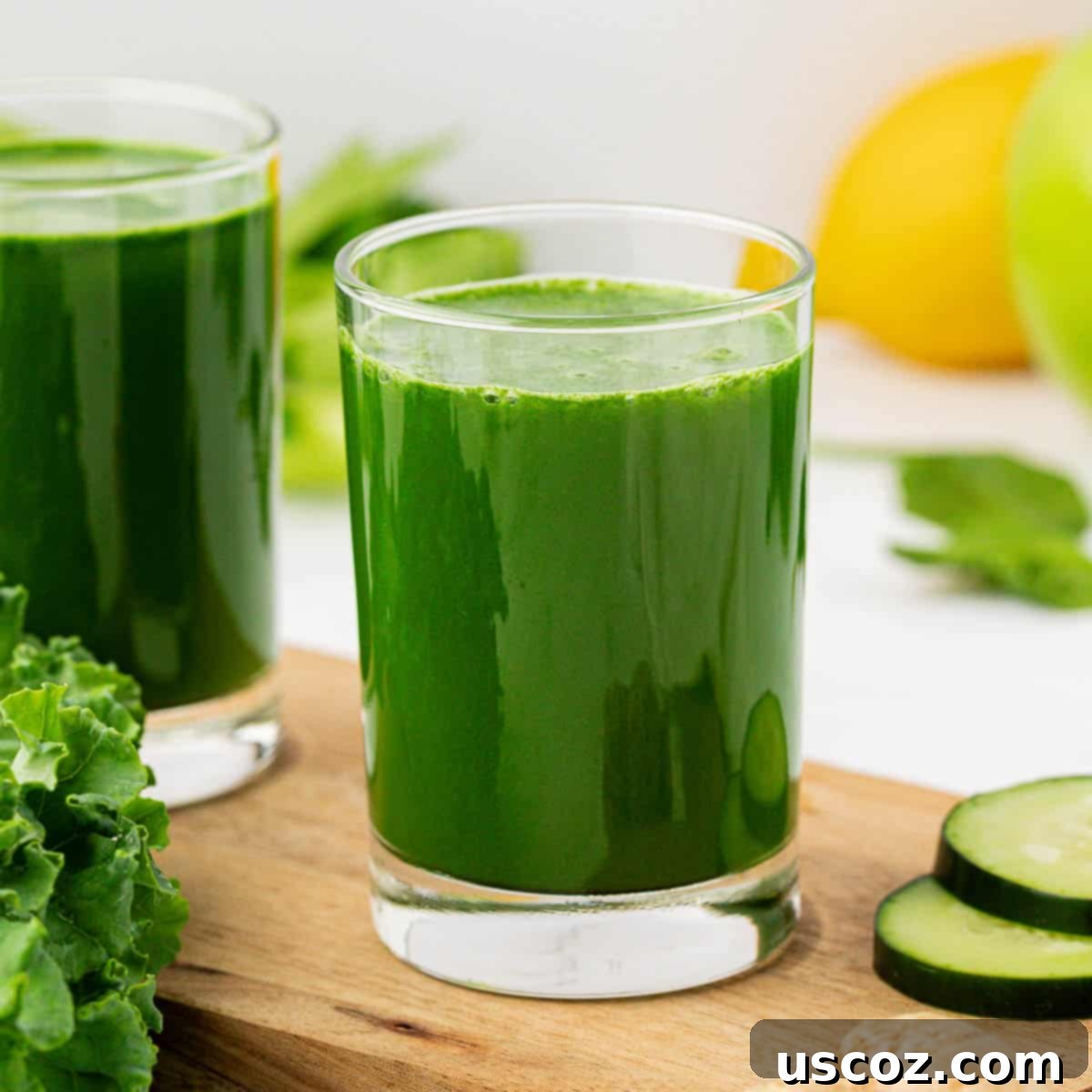The Ultimate Easy Green Juice Recipe: Boost Your Health with Fresh Greens
Discover the best Green Juice Recipe crafted with a powerful blend of kale, crisp cucumbers, zesty lemon, crunchy celery, vibrant spinach, sweet green apples, and a kick of ginger.
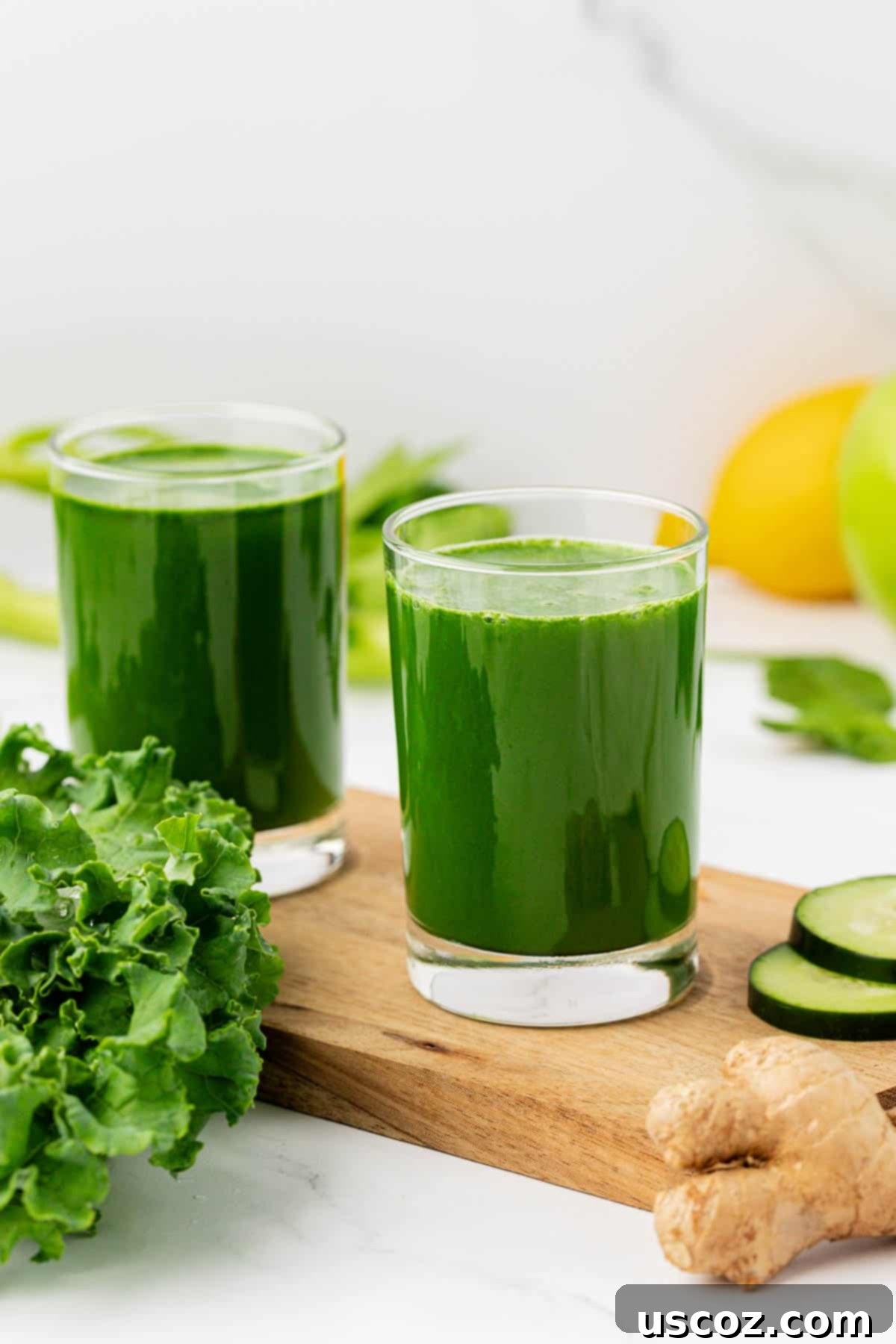
Why This Green Juice is a Must-Try!
Incorporating a glass of fresh green juice into my morning routine has been a game-changer for years. While I firmly believe in whole foods and never advocate for replacing full meals with juice, nor do I promote juice fasts, the act of juicing provides a swift and efficient way to infuse my body with a concentrated dose of essential nutrients. It’s an incredibly simple yet effective method to increase your daily vegetable intake, especially if you find it challenging to eat enough greens throughout the day.
The difference I feel when I consistently enjoy fresh, cold-pressed juice is remarkable. There’s a noticeable uplift in my energy levels, an improvement in clarity, and an overall sense of well-being that I eagerly anticipate each day. It’s more than just a drink; it’s a vital part of my personal wellness ritual.
My journey with juicing began in my teenage years, where I often consumed generous portions of 25-40 ounces first thing in the morning. This early introduction solidified my appreciation for the powerful impact of fresh produce. This particular recipe is not only packed with goodness but is also incredibly balanced in flavor, making it perfect for both seasoned juicers and those just starting their green journey.
The Incredible Benefits of Green Juice
Beyond its refreshing taste, a well-balanced green juice offers a plethora of health advantages that can significantly contribute to your overall well-being:
- Nutrient Powerhouse: Green juice is a concentrated source of vitamins (like A, C, K), minerals (iron, calcium, magnesium, potassium), and antioxidants. These vital nutrients support everything from bone health to immune function.
- Enhanced Hydration: Made primarily from water-rich fruits and vegetables, green juice helps keep your body optimally hydrated, which is crucial for all bodily functions, including digestion, nutrient transport, and temperature regulation.
- Improved Digestion: While juicing removes most fiber, the enzymes present in fresh raw vegetables can aid digestion and nutrient absorption. For some, the absence of fiber can give the digestive system a temporary rest, allowing nutrients to be absorbed more readily.
- Energy Boost: The immediate absorption of vitamins and minerals provides a natural and sustained energy boost without the jitters associated with caffeine. Many people report feeling more vibrant and focused after incorporating green juice into their diet.
- Skin Radiance: The high antioxidant content helps combat free radicals, which can lead to healthier, more radiant skin. Vitamins A and C, in particular, are known for their role in skin repair and collagen production.
- Detoxification Support: Ingredients like kale, spinach, and celery are known for their detoxifying properties, helping your body naturally cleanse and eliminate toxins.
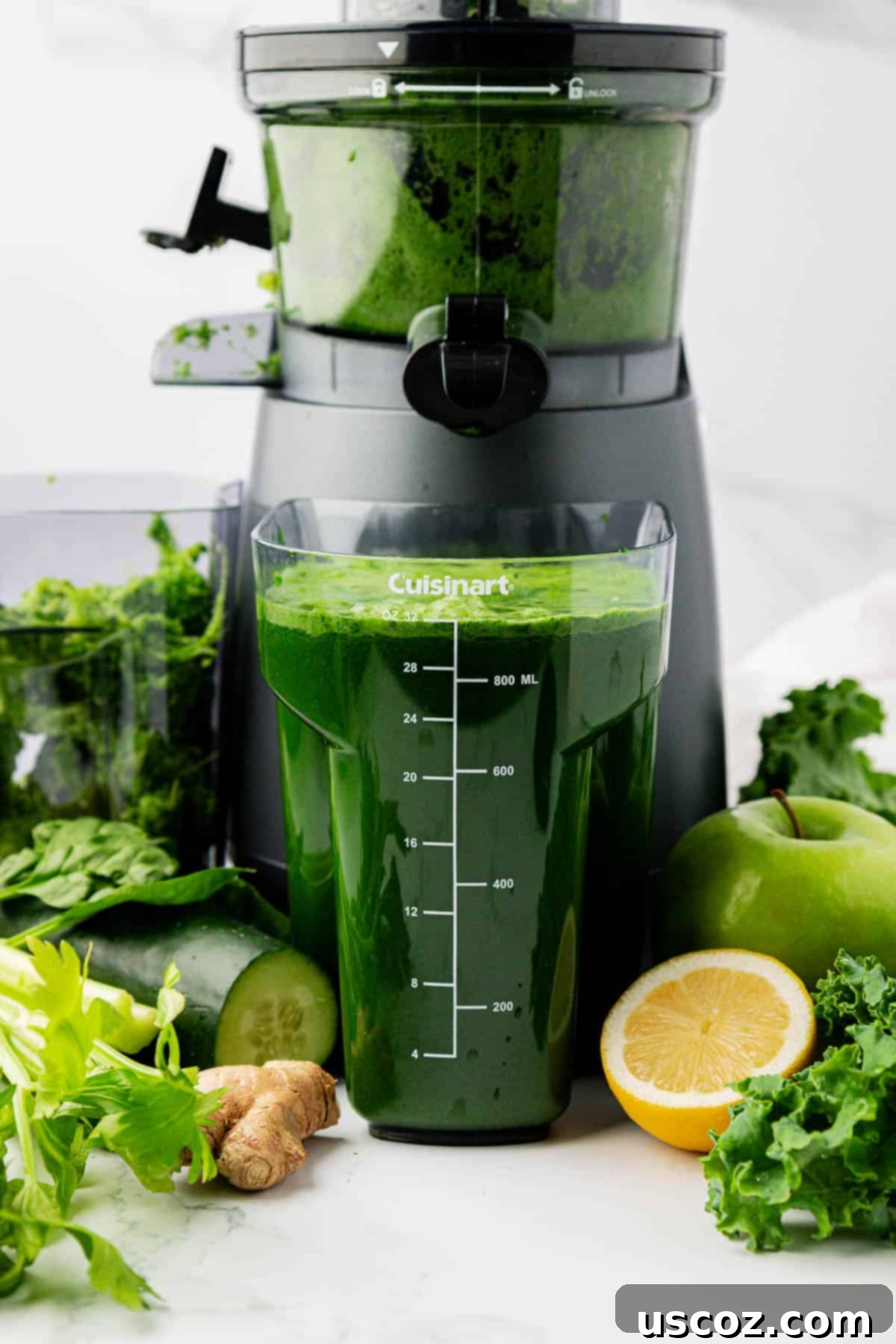
Ingredients to Make This Delicious Green Juice
Here’s what you’ll need to gather for this vibrant green juice, along with quick preparation tips:
- 1 bunch of kale: Ensure it’s thoroughly washed, and remove the tough stems for a smoother juice. Kale is a powerhouse of Vitamin K, A, and C, and essential minerals.
- 1 lemon: Peeled. Lemon not only adds a bright, refreshing tang but is also rich in Vitamin C and helps balance the earthy flavors of the greens.
- 6 stalks of celery: Washed well. Celery is known for its hydrating properties and mild flavor, packed with vitamins and minerals like potassium and Vitamin K.
- 1 large cucumber: Peeled. Cucumbers are incredibly hydrating and add a refreshing, mellow base to the juice, rich in Vitamin K and antioxidants.
- 2 cups baby spinach: Washed. Spinach is another nutrient-dense green, high in iron, Vitamin K, and Vitamin A, and contributes to the juice’s vibrant color.
- 2 green apples: Washed and cored. Green apples add natural sweetness to counteract bitterness and are a good source of fiber (though mostly removed in juicing) and antioxidants. They are key to making this recipe palatable for beginners.
- 1” piece of ginger: Peeled. Ginger provides a warm, spicy kick and is renowned for its anti-inflammatory and digestive benefits.
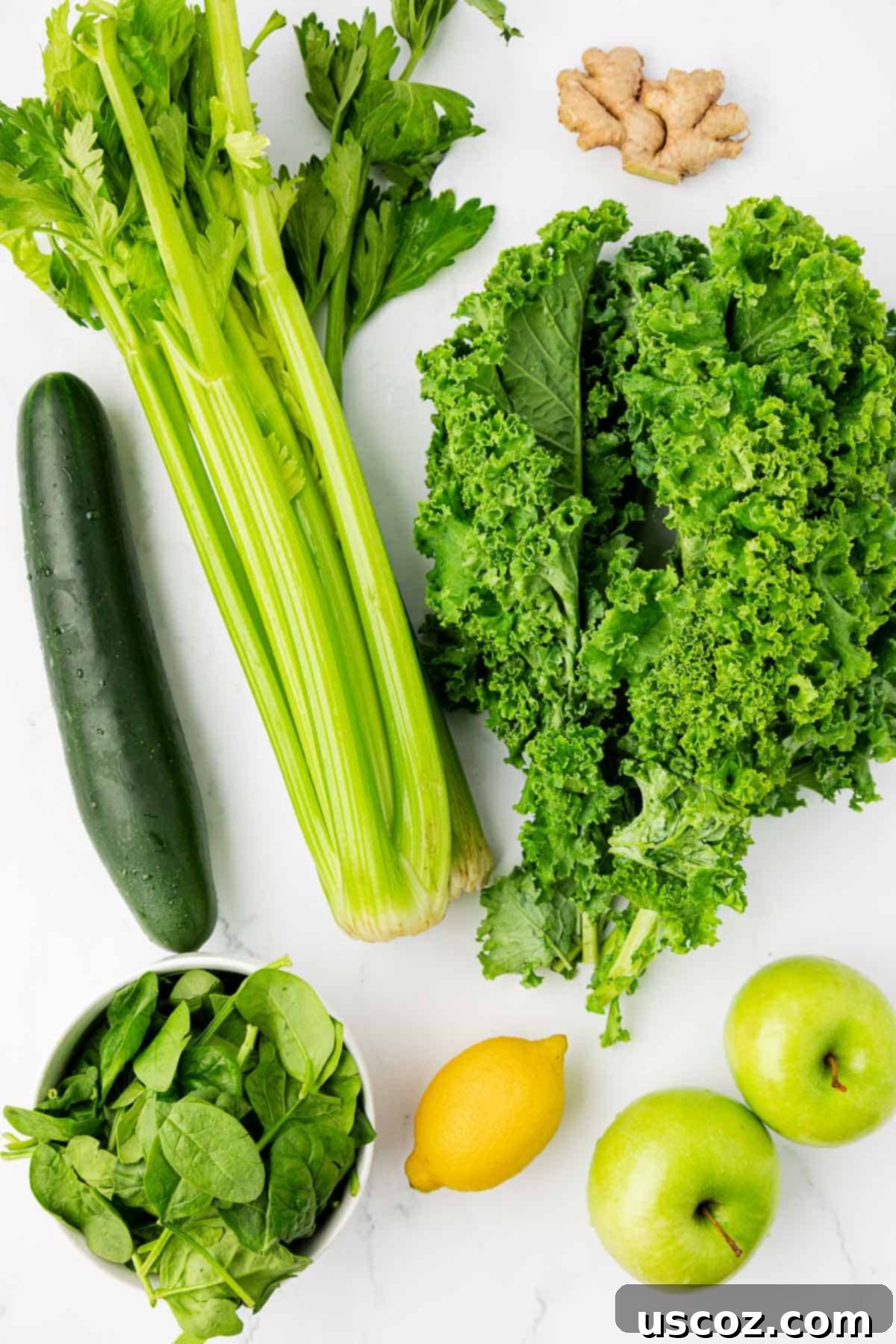
How to Make Green Juice: Step-by-Step Guide
Making your own fresh green juice is a simple process that yields incredible results. Follow these steps for the perfect blend:
Step 1: Wash and Prepare Your Produce
Thoroughly wash all your fruits and vegetables. This step is crucial to remove any dirt or pesticides. For the apples, make sure to core them completely, as apple seeds contain small amounts of cyanide and are best avoided. When it comes to the lemon, I highly recommend peeling it. While some juicers can handle the peel, lemon zest can be quite potent and may overpower the delicate flavors of the greens, resulting in a bitter taste. Peeling ensures a smoother, more balanced flavor profile.
Joy’s Tip for Perfect Juice
Peeling your cucumber is an optional step. However, I’ve found that my juicer operates more efficiently and yields a better-textured juice without the thick cucumber skin. If your juicer struggles with tougher skins, or if you prefer a less pulpy consistency, peeling is a great choice. Additionally, the crispness and natural sweetness of the apples and lemon play a vital role in taming the robust flavor of the green vegetables. This makes the juice far more palatable and enjoyable, especially if you’re new to juicing. It’s truly a fantastic way to gently introduce yourself to the vibrant taste of fresh, homemade juice.
If you ever find the flavor of any juice recipe a bit too intense or earthy for your liking, don’t hesitate to add an extra green apple. The additional sweetness will help balance the flavors and make the vegetable juice more approachable until your palate adjusts to the rich taste of fresh greens.
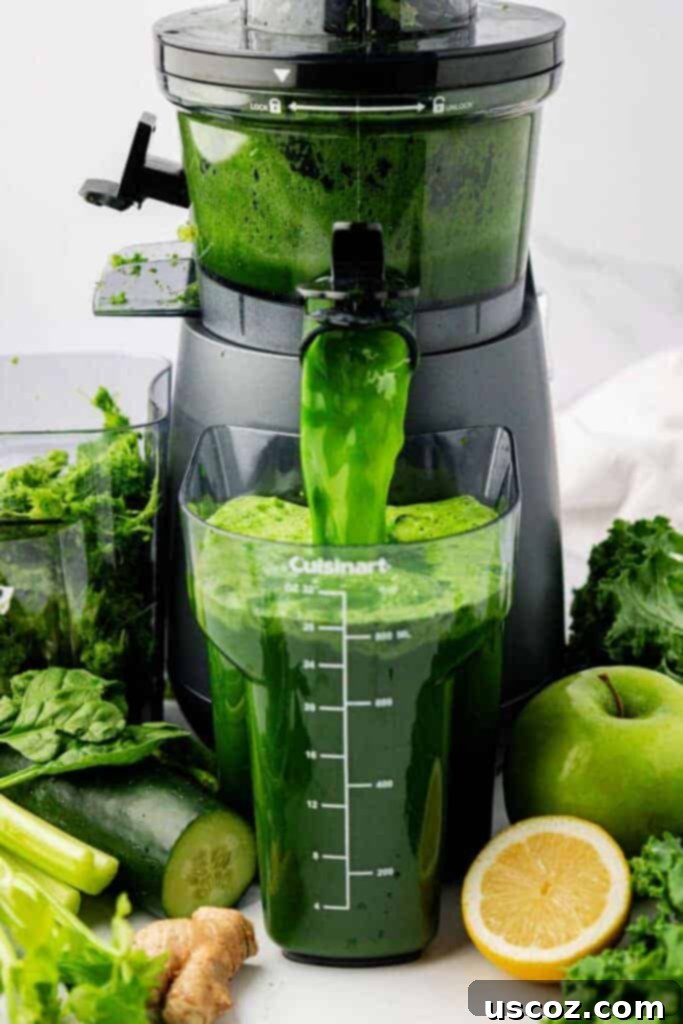
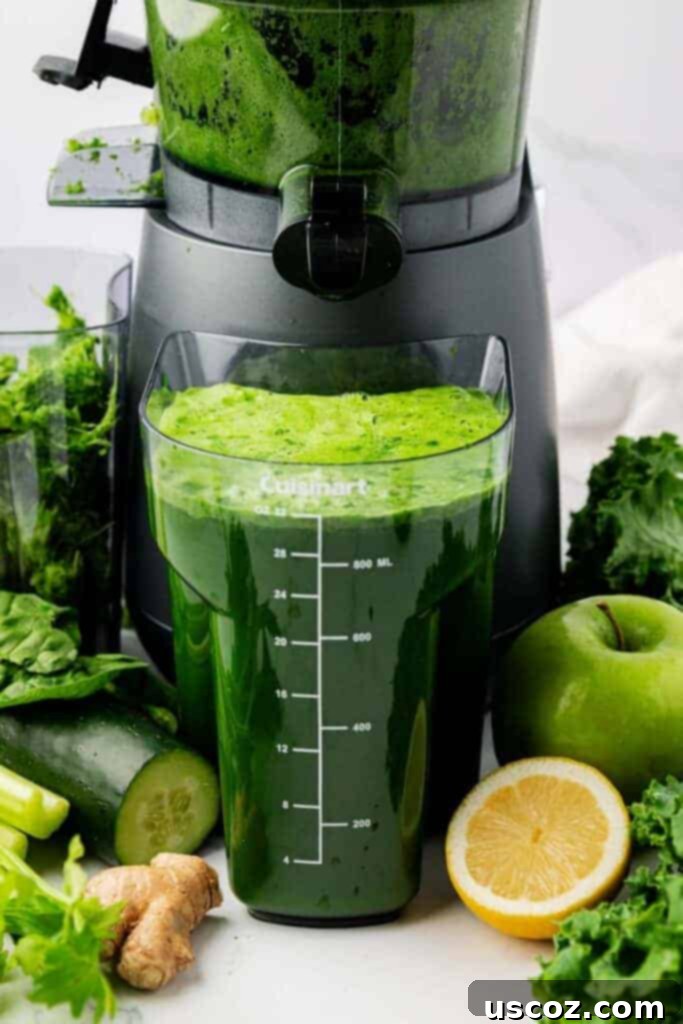
Step 2: Juice and Serve
Once all your ingredients are prepped, carefully feed them through your juicer according to its manufacturer’s instructions. Alternate between harder and softer ingredients to help the juicer process everything smoothly. For instance, follow kale or spinach with an apple or a piece of celery. Serve your freshly pressed green juice immediately to enjoy its maximum nutritional benefits and vibrant taste. If you have leftovers, store them properly for later enjoyment.
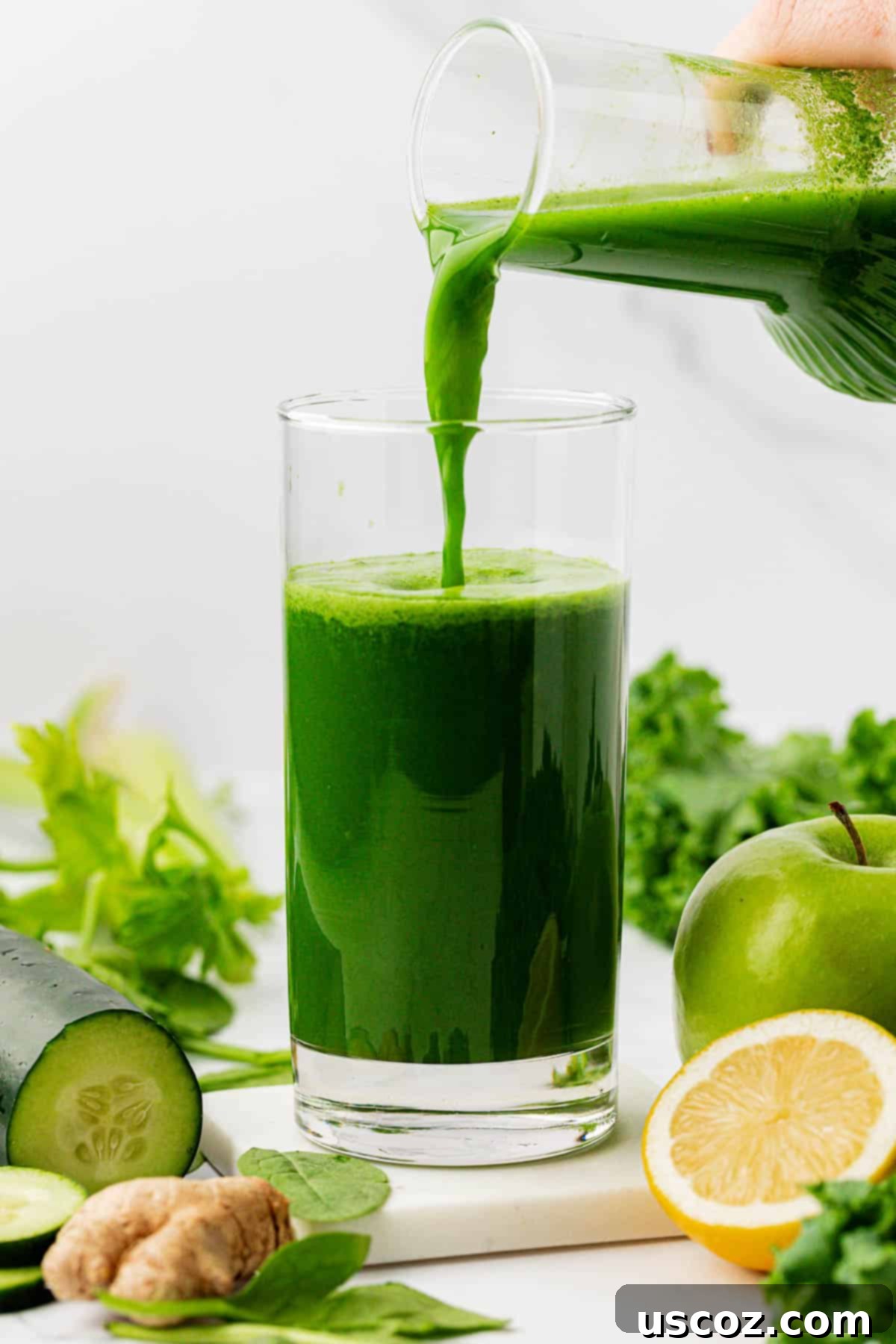
This recipe is exceptionally beginner-friendly and serves as a fantastic introduction to the world of juicing. If your goal is to significantly increase your daily intake of fruits and vegetables, juicing provides a powerful and convenient way to make a big nutritional difference in a minimal amount of time.
Equipment for Optimal Juicing Results
To get the most out of your green juice recipe, the right equipment makes a difference. There are two main types of juicers:
- Centrifugal Juicers: These are generally more affordable and faster, using a spinning blade to extract juice. They work well for most fruits and vegetables but can produce more foam and introduce heat, potentially reducing some nutrient content.
- Masticating (Cold Press) Juicers: These work by slowly crushing and pressing ingredients, minimizing heat and oxidation. They are more efficient at extracting juice from leafy greens and typically yield a higher quality, more nutrient-dense juice with less foam. They are often more expensive and slower but are favored by serious juicers.
For this green juice recipe, either type will work, but a masticating juicer will likely give you a higher yield from the kale and spinach, and a more potent juice.
How Many Calories are in a Cup of Green Juice?
The caloric content of green juice can vary depending on the specific ingredients and their proportions. However, for this particular recipe, a standard cup (approximately 8 ounces) of green juice contains around 88 calories. This makes it a low-calorie, nutrient-dense beverage option.
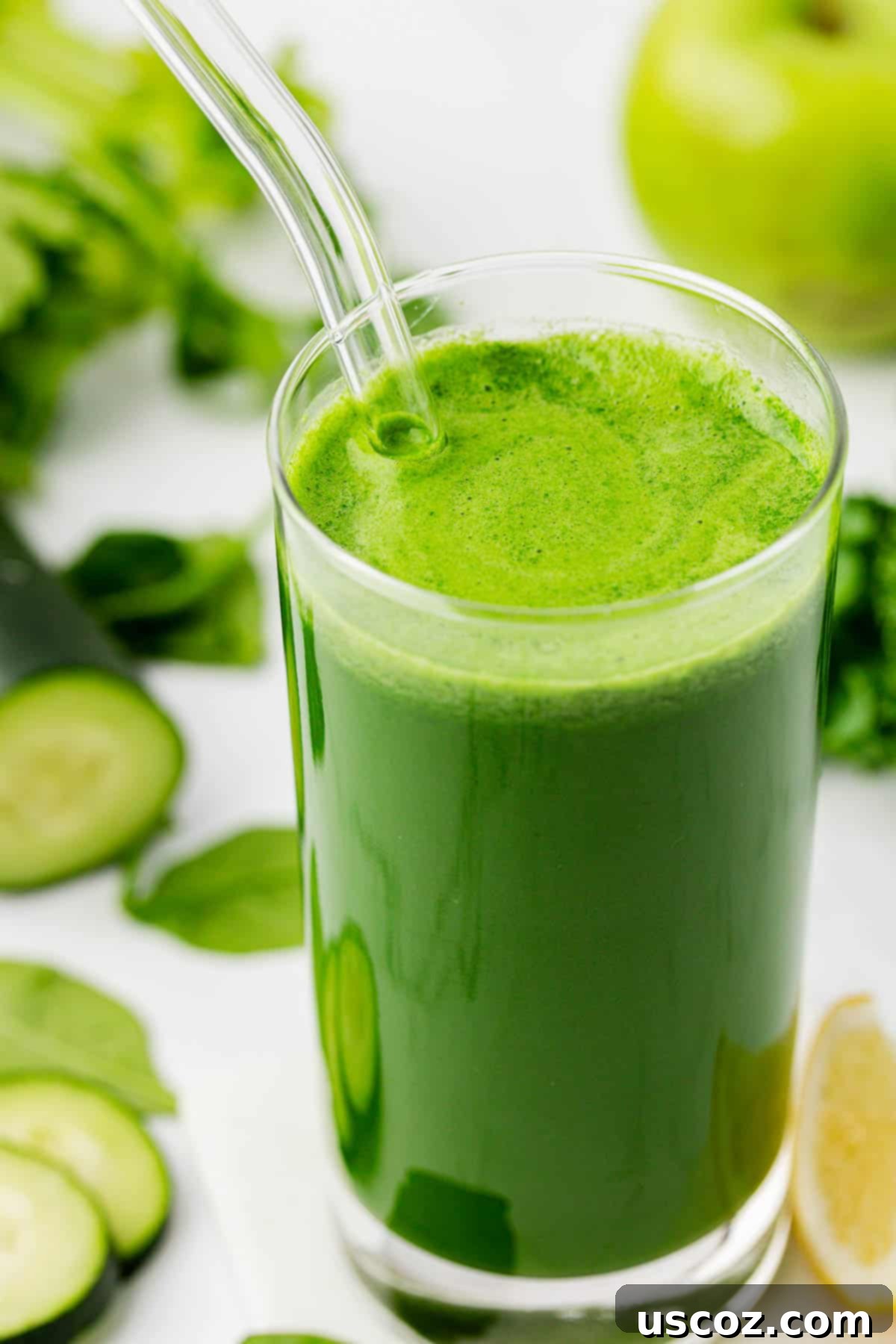
What to Do with Leftover Juicing Pulp
After juicing, you’ll be left with a substantial amount of pulp. While I often choose to compost it, there are many creative and resourceful ways to utilize this fibrous byproduct, reducing waste and adding nutrition to other dishes. You can find numerous ideas for using leftover juice pulp, such as incorporating it into vegetable broths, adding it to baked goods (like muffins or crackers), or even mixing it into veggie burgers. Don’t let those valuable plant fibers go to waste!
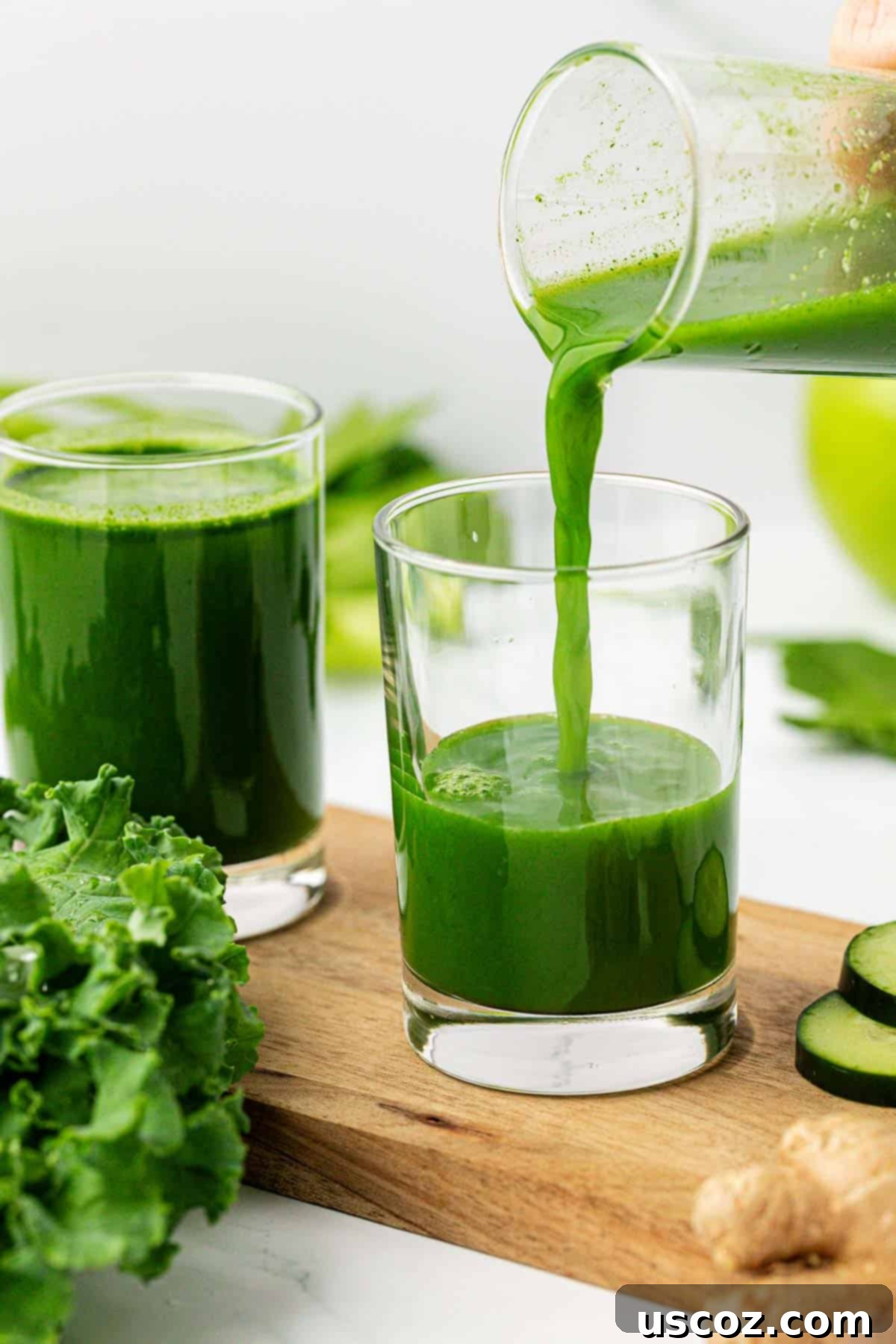
Is Juicing or Blending Better? Understanding the Debate
The “juicing vs. blending” debate is a common one, largely because juicing removes the fiber from fruits and vegetables, which blending retains. Both methods offer unique benefits, and the “better” option often depends on your individual health goals and preferences.
- Juicing: Provides a concentrated dose of vitamins, minerals, and enzymes that are easily absorbed by the body. Without fiber, the digestive system doesn’t have to work as hard, allowing for a quicker nutrient delivery. This can be beneficial for those with digestive issues or looking for a rapid nutrient boost.
- Blending: Creates a smoothie that retains all the fiber from the produce. Fiber is essential for digestive health, blood sugar regulation, and satiety. Smoothies are more filling and can be a great way to incorporate whole foods.
For me, juicing allows me to consume a far greater quantity and variety of fruits and vegetables than I could possibly eat in a single sitting. While I might not be able to sit down and eat all the kale, spinach, celery, cucumber, apples, lemon, and ginger in this green juice at once, I can certainly drink it! And when it tastes this absolutely delicious, it becomes an effortless and enjoyable way to supercharge my nutrient intake.
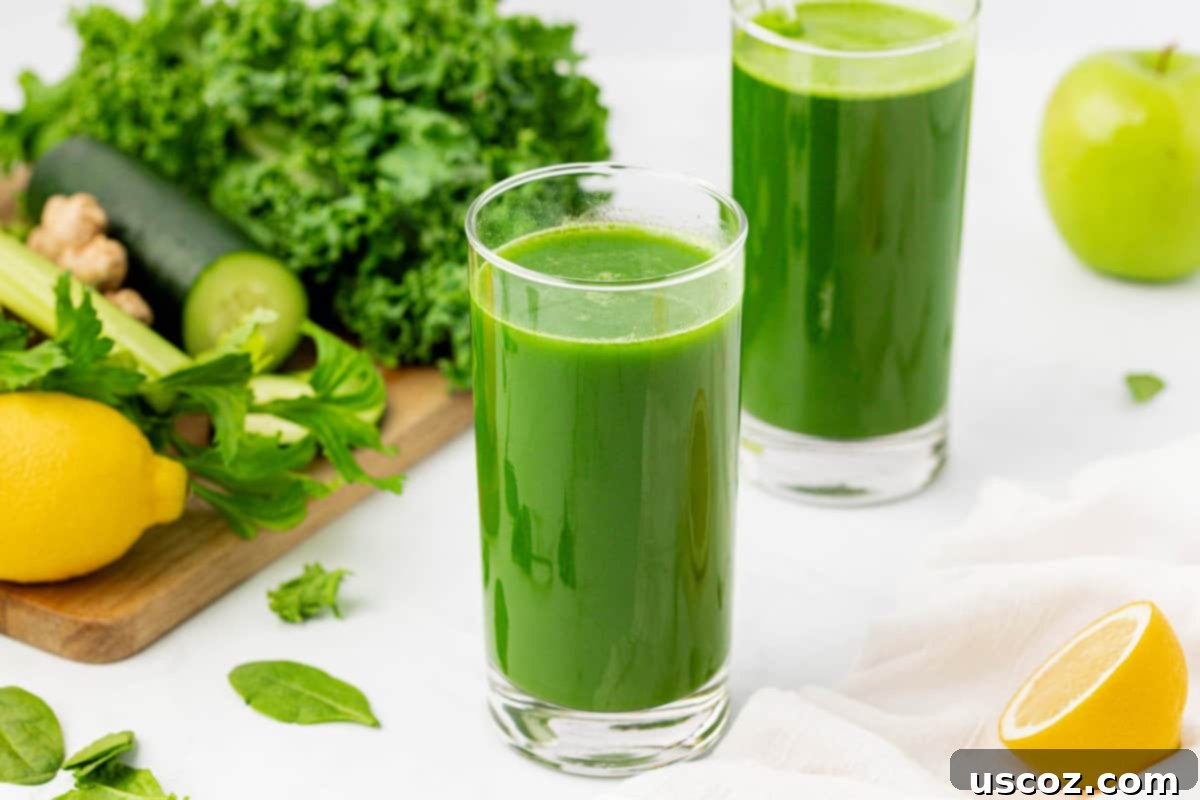
This particular green juice recipe is especially wonderful for those who might not yet have developed a strong appreciation for the earthy taste of vegetable juice. The bright, zesty fresh lemon combined with the crisp, sweet green apple creates a perfectly balanced and incredibly refreshing taste that you’ll undoubtedly find yourself craving time and again!
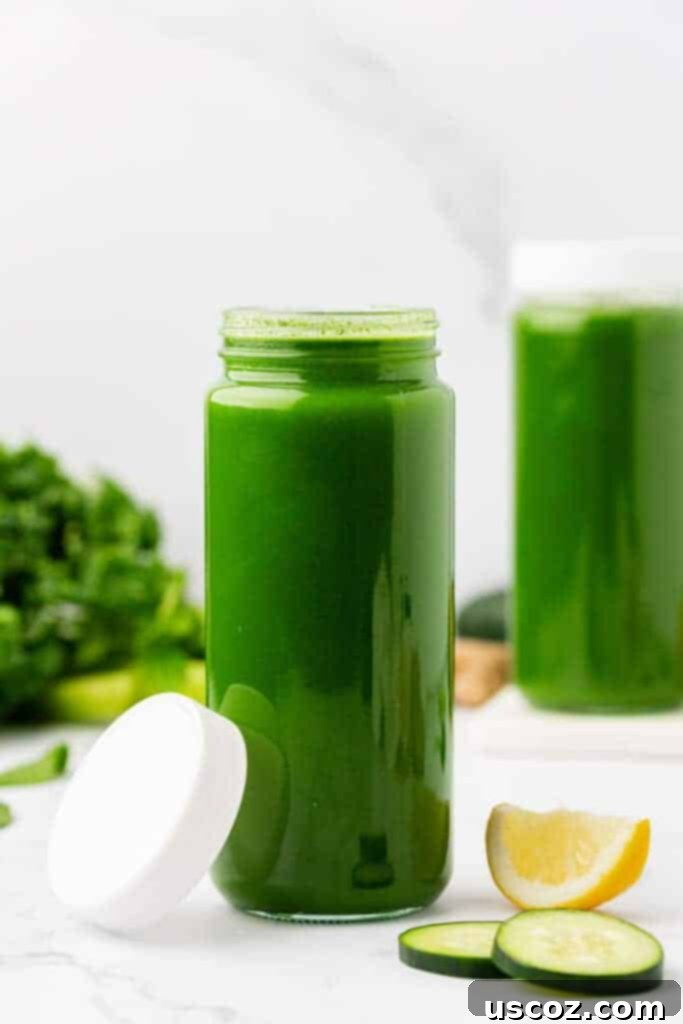
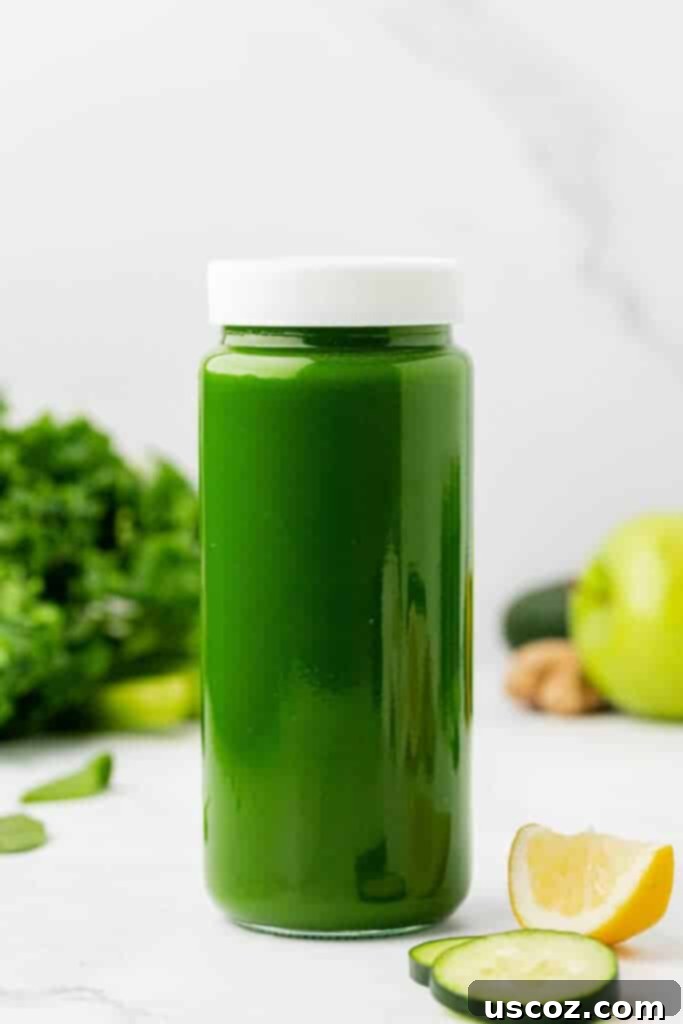
Storing Your Fresh Green Juice for Maximum Freshness
While fresh juice is always best consumed immediately to capture its peak nutrient content and vibrant flavor, life often requires us to prepare ahead. I frequently make extra juice for the following day or store any leftovers. To maintain optimal freshness, it’s crucial to minimize exposure to air and light, which can degrade nutrients and flavor.
This green juice can be effectively stored in a glass bottle or jar with an airtight lid in the refrigerator for up to 24 hours. To ensure the best possible freshness, try to fill the container completely to the brim before sealing it with the lid. This technique helps reduce the amount of oxygen that comes into contact with the juice, slowing down oxidation. I keep a variety of 4 oz, 8 oz, and 16 oz jars on hand, perfect for storing different quantities of leftover juice.
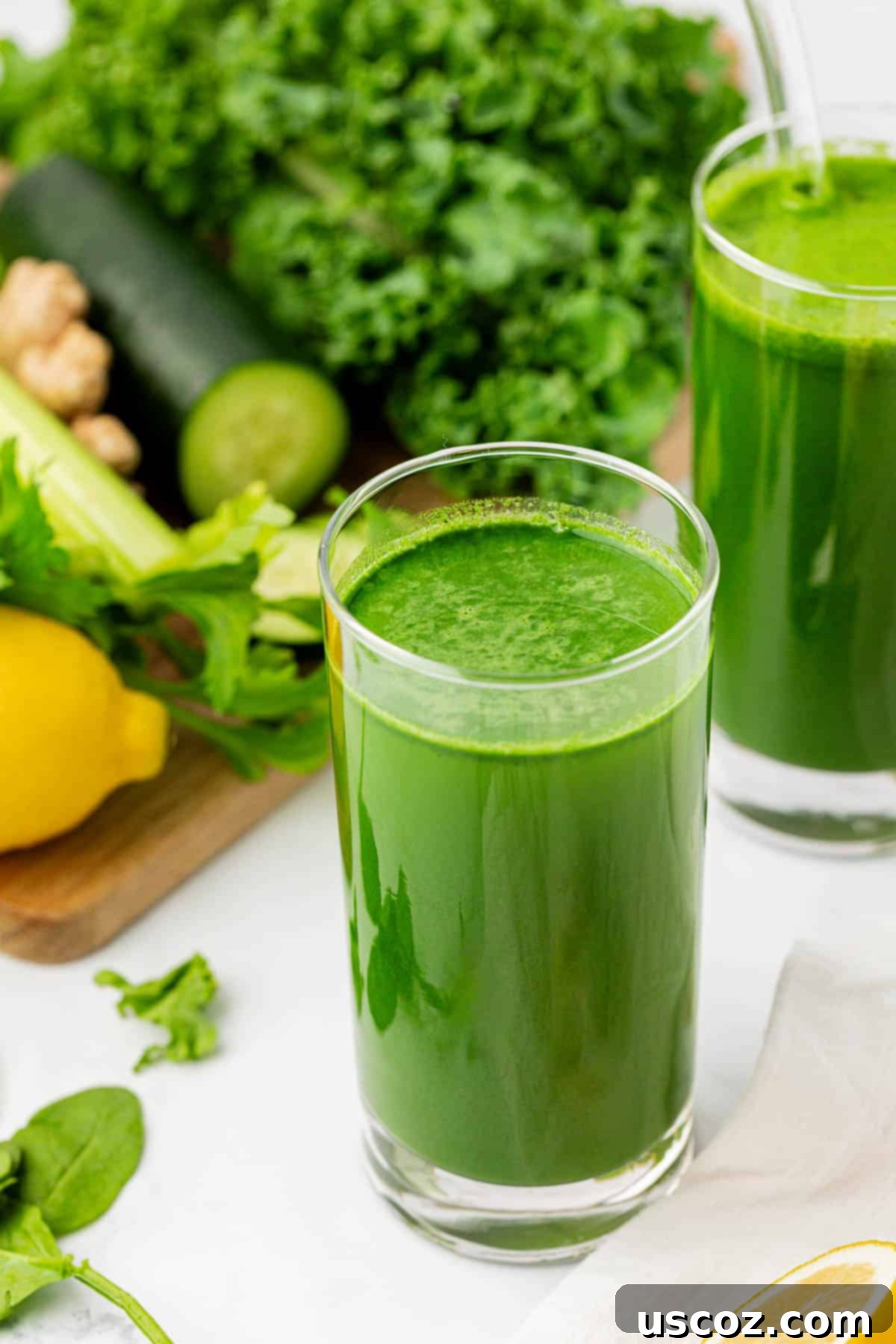
Explore More Delicious Juicing Recipes
If you love this green juice, you’ll be excited to try these other fantastic juicing recipes to expand your healthy beverage repertoire:
- Cucumber Juice: Refreshing and hydrating.
- Spinach Juice: A gentle way to boost iron and vitamins.
- Green Apple Juice: Sweet, tart, and invigorating.
- Immunity Shots: Concentrated shots for a powerful health boost.
- Carrot Orange Juice: A classic sweet and vibrant blend.
- Kale Juice: Maximize your greens intake with this powerful juice.
- Vegetable Juice: A versatile recipe for using mixed veggies.
- Carrot Juice: Sweet and excellent for vision health.
- Celery Juice Recipe: Simple and great for digestion.
- Pineapple Cucumber Juice: A tropical twist with hydrating power.
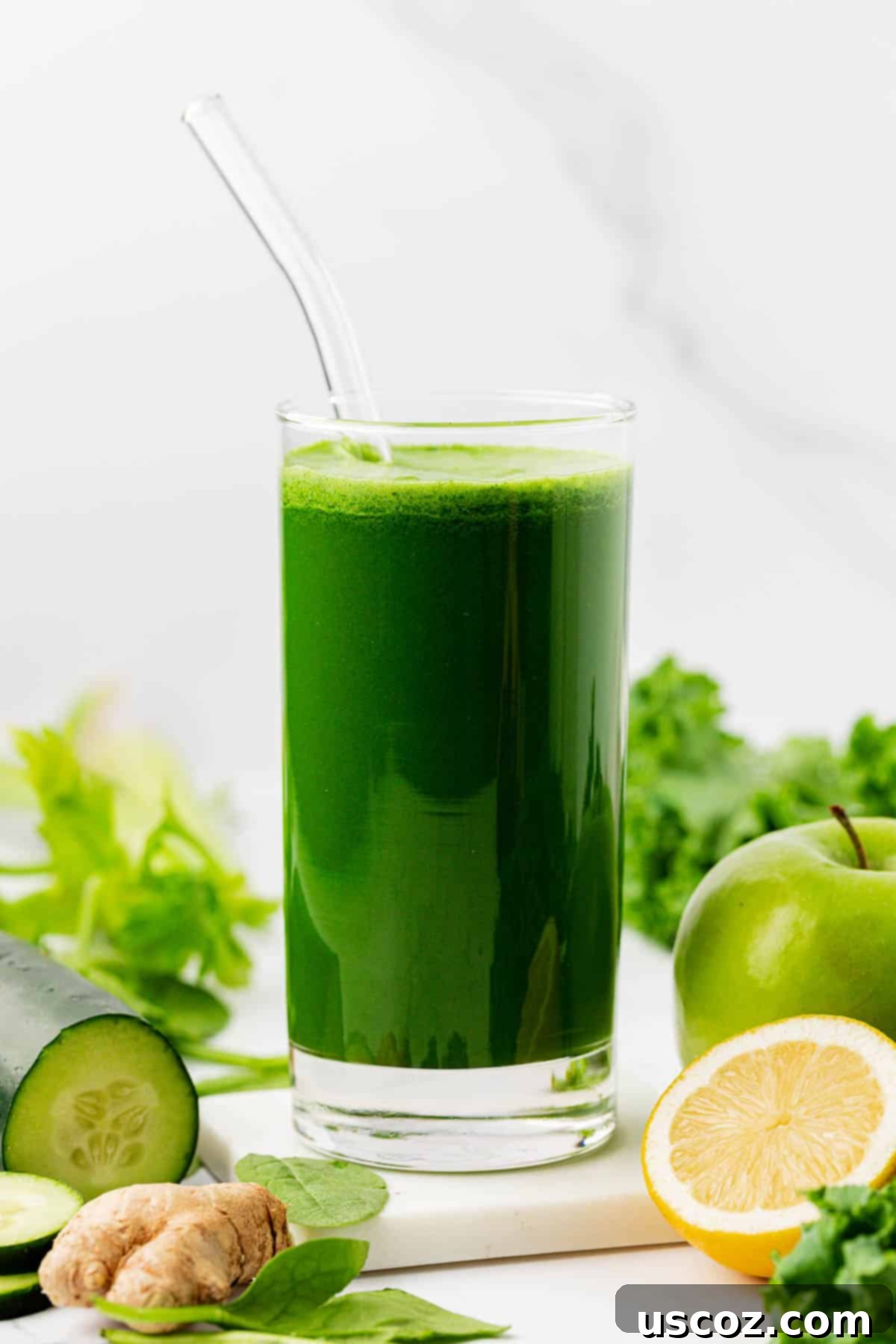
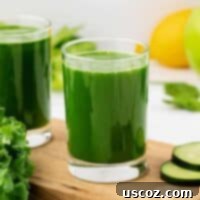
Green Juice Recipe
Save RecipeSaved!
Pin Recipe
Rate Recipe
Print Recipe
Ingredients
- 1 bunch of kale, washed and stems removed
- 1 lemon, peeled and quartered
- 6 stalks of celery, washed
- 1 large cucumber, peeled and cut into long strips
- 2 cups baby spinach
- 2 green apples, cored and sliced
- 1 inch piece of ginger, peeled
Instructions
-
Wash and prepare all your fruits and vegetables as described above. Ensure all tough stems are removed from kale, apples are cored, and lemon and ginger are peeled.
-
Carefully feed all prepped ingredients into your juicer. For best results, alternate between harder items like apples and celery, and softer leafy greens like kale and spinach.
-
Serve your delicious green juice immediately to enjoy its peak freshness and nutrient content. For any leftover juice, store it in an airtight glass container in the refrigerator for up to 24 hours.
Nutrition
Like this recipe? Rate and comment below!
Embrace the vibrant taste and incredible health benefits of this easy green juice recipe. It’s a simple step towards a healthier lifestyle, offering a delicious way to nourish your body with essential nutrients every single day. Start juicing today and feel the difference!
